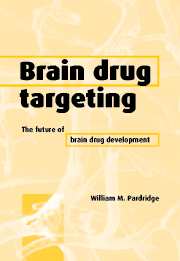Book contents
- Frontmatter
- Contents
- Preface
- List of abbreviations
- 1 Drug targeting, drug discovery, and brain drug development
- 2 Invasive brain drug delivery
- 3 Lipid-mediated transport and carrier-mediated transport of small molecules
- 4 Receptor-mediated transcytosis of peptides
- 5 Vector discovery: genetically engineered Trojan horses for drug targeting
- 6 Linker strategies: the engineering of multifunctional drug formulations
- 7 Protein neurotherapeutics and peptide radiopharmaceuticals
- 8 Antisense neurotherapeutics and imaging gene expression in vivo
- 9 Gene therapy of the brain
- 10 Blood–brain barrier genomics
- References
- Index
- Plate section
Preface
Published online by Cambridge University Press: 08 January 2010
- Frontmatter
- Contents
- Preface
- List of abbreviations
- 1 Drug targeting, drug discovery, and brain drug development
- 2 Invasive brain drug delivery
- 3 Lipid-mediated transport and carrier-mediated transport of small molecules
- 4 Receptor-mediated transcytosis of peptides
- 5 Vector discovery: genetically engineered Trojan horses for drug targeting
- 6 Linker strategies: the engineering of multifunctional drug formulations
- 7 Protein neurotherapeutics and peptide radiopharmaceuticals
- 8 Antisense neurotherapeutics and imaging gene expression in vivo
- 9 Gene therapy of the brain
- 10 Blood–brain barrier genomics
- References
- Index
- Plate section
Summary
The theme of this book is that brain drug development in the twenty-first century will be limited by the innovation in brain drug-targeting science. In the twentieth century, drug development for the brain, and other organs, was a chemistry-driven science that created small molecule pharmaceuticals. These drugs are lipid soluble and have molecular weights under a threshold of approximately 500 Da. In the twenty-first century, central nervous system (CNS) drug development will be biology-driven and will create large molecule pharmaceuticals, such as recombinant proteins, monoclonal antibodies, antisense drugs, and gene medicines.
The singular driving force behind the future development of large molecule pharmaceuticals is the new science of genomics and the availability of the complete sequence of the human genome. The use of gene microarray technologies will enable the discovery of thousands of disease-specific genes, and thousands of secreted proteins and their cognate receptors. However, in the absence of a functional platform for CNS drug-targeting science, the large molecule pharmaceuticals cannot be delivered to brain and, accordingly, the therapeutic potential of these molecules will not be realized. When brain drug-targeting science develops, and the remarkable pharmacologic actions of large molecule pharmaceuticals in the brain are documented (because these molecules were actually delivered to brain cells), the development of large molecule neuro pharmaceuticals will continue to expand in the twenty-first century. In this scenario, the separation of the “cart” and the “horse” is clear. Brain drug-targeting science is the “horse” and large molecule pharmaceuticals are the “cart.” If brain drug-targeting science is not developed, then the large molecules will not be developed as neuropharmaceuticals.
- Type
- Chapter
- Information
- Brain Drug TargetingThe Future of Brain Drug Development, pp. ix - xPublisher: Cambridge University PressPrint publication year: 2001



